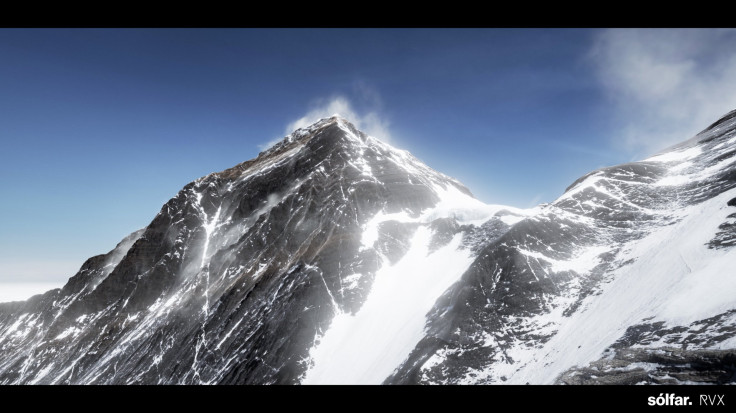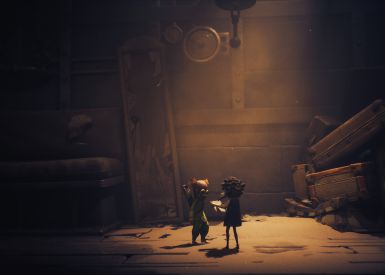You enter a small, unassuming room. You are assisted in strapping on the HTC Vive headset, which covers your eyes so firmly that not a peep of stray light beams through. Your ears are only your own for another few moments before snug headphones are placed over them. As the demo powers up, a blue grid pulses at the edges of your new reality. These faint lines, meant to protect you from running full-speed into a wall, are the only indication you have that the virtual reality you now inhabit is not real.
That was how my hands-on experience with the Everest VR demo from Sólfar Studios began. Thanks to a collaboration with RVX , the Reykjavik-based visual effects and animation studio that brought us the film Everest (2015) , the team at Sólfar Studios has access to all the assets that made Everest (2015) so memorable. This means that Everest VR , even in demo, has a level of realism and detail that is unmatchable.

Everest VR sells itself. “This is the kind of thing you want to show to your guests,” said Game Design Director Petur Thorarinsson. “Everest doesn’t require any introduction. Everyone knows about Everest, and people may not actively be curious about it, but if they get a chance, they’re like, ‘Hell yeah!’ I think it has a really wide appeal.”
The Everest VR demo is divided into 3 sections, each of which is preceded by an interesting educational voice-over and very brief instructions for the controls. I particularly liked the informative narration, which emphasized the danger a human body faces on such a high ascent. “As soon as you go above the Death Zone your body starts deteriorating and you just can’t stay there very long,” Thorarinsson explained. “The mortality rate is pretty high for many of the routes. None of them are really safe, they’re pretty dangerous.”
Unlike real life, in the Everest VR demo, you can stay and wander for as long as you like -- but you may not want to. That narration gives you a compelling sense of urgency, enumerating as it does both the science of climbing and the challenges peculiar to Everest itself, like nightfall, avalanches, and an ever-shifting landscape. After the narration, you’re tasked with simple actions in short segments that are very intuitive to control.

The first section takes place in the Khumbu Ice Falls, requiring you to use the controls in your hand to grip onto cables as you walk over a ladder above a huge crevasse. No matter where I looked, I saw peaks and clouds, ice and snow. I prided myself on moving briskly and fearlessly across the ladder at first. But halfway through, I realized that my urgency was driven by fear.
Fear! I knew perfectly well that I was walking in absolute safety across a soft carpet in a small office in Midtown. Still, I felt a fear of slipping on the icy ladder and falling into dreadful darkness. Fear: an impressive achievement for a game that’s more educational experience than gamified journey.
That doesn’t mean that Sólfar hasn’t run into challenges. “There’s a lot of game design things that we need to solve. It’s just in its infancy so no one really knows how to figure it out,” said Thorarinsson. “We want to be as close as possible to photo reality. We think it’s really, really important, optimizing it so that it actually runs on video cards that people actually have.”
Another problem: how to keep people from getting nauseous. “That’s a big thing. That’s completely unacceptable. We would never want to make anyone sick…. [but] moving around, doing that in first-person is just not solved.”

Back in the Khumbu Ice Falls, I wasn’t nauseous, but I couldn’t escape my own nerves. I forced myself to stop and look around at the blindingly sunny day. I even gazed into the abyss, but man, what a sensation it gave me when it stared back. I couldn’t bring myself to release my grip on the virtual cables and step off of that ladder, even knowing that in another world, I was in a small, unassuming room.
I’m not alone in that. “When you walk across the ladder over the crevasse, we had multiple people freak out halfway and start running. I had someone run straight into the wall,” Thorarinsson said. “People just have a really, really strong response.”
While the thought of stepping off the ladder didn’t even occur to me until after the demo, Thorarinsson states that the team may include a separate mode that allows you to do so. “Some people want to do it but they just can’t get themselves to do it. It’s already super scary,” he said. “Usually people who actually step off the ladder and into the abyss are programmers who are trying to debug it.”

The next section of the Everest VR demo involved scaling the Lhotse Face. This meant using controls to grip the sides of the ladder, which moved you upwards. There was no need to move your feet to ascend, which made everything feel a little less real. This is not a criticism: this is a blessing. All the same, the vanishing view of Everest below me and the creak and groan of the ice around me made me hurry.
Finally, there was a fascinating diorama mode that allowed you to manipulate the scale of the landscape and zoom in at various camps on the Hillary Step. I felt like an Olympian god. At one point I was clipping through a mountain. It was awesome. According to Thorarinsson, that area should see a lot more additions, like more locations to zoom in on and more infographics about other routes and Everest history.
The Everest VR experience takes you from base camp all the way to the summit, though the team is still undecided as to how many other gameplay sections Everest VR will have. At least 5 or 6 other famous locations on the way up the mountain should be added before Everest VR launches, hopefully coinciding with the launch of the HTC Vive, though nothing is confirmed yet. There’s no pricing information yet, either. The studio is looking forward to exploring more extreme locations on Earth, though mum’s the word for now.
As for the summit itself, Everest VR will absolutely take you there. “The view up there is absolutely gorgeous. I can promise you that,” Thorarinsson said.

I believe it.


















